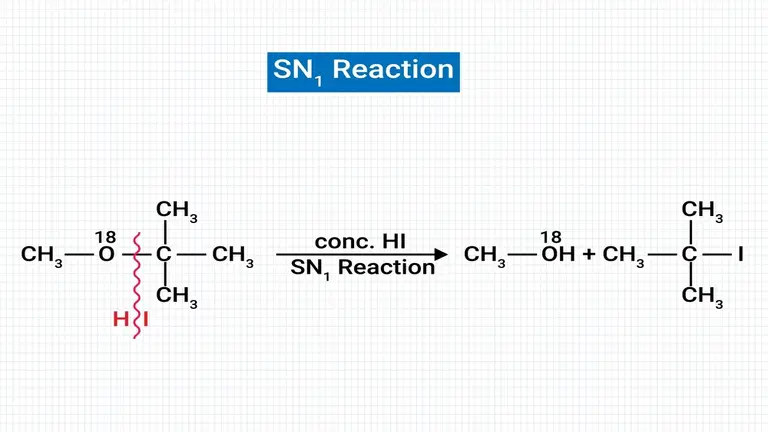The difference between SN1 and SN2 is that sn1 is of the first order, whereas SN2 is of the second order.
This is practically the most significant distinction.
Therefore, the slowest step of sn1 only requires one reactant, whereas the slowest step of SN2 requires two reactants.
The SN1 and SN2 reactions are both nucleophilic substitution processes.
The number of molecules engaged in the crucial reaction stages makes a difference.
SN1 has a single molecular structure. This indicates that only one molecule is involved in the rate-defining step.
It is bimolecular, SN2. This implies that two molecules are involved in the rate-defining step.
These significant variations lead to several further variations between SN1 and SN2 reactions, which we will describe below, along with their features.
To read more, scroll down to the section below.
Table of Contents
Nucleophilic Substitution Reaction

It’s crucial to understand a nucleophilic substitution reaction to better understand the difference between SN1 and SN2 reactions.
A substitution reaction in which an atom or functional group is changed for one that has a single pair of electrons, a negatively charged ion, or both.
In an attempt to replace the functional group or atom already linked to the positive area.
The negatively charged ion or the atoms/molecules with lone pairs of electrons will be drawn to the positively charged area of an atom or complex.
What is SN1 reaction?

The “SN1 reaction” is a substitution reaction, where “SN” stands for “substitution nucleophilic” and the “1” indicates a unimolecular rate-determining step.
An electron-rich nucleophile displaces the halogen atom bound to the central carbon of an alkyl halide molecule in a process known as the SN1 reaction.
An electron-rich nucleophile displaces the halogen atom bound to the central carbon of an alkyl halide molecule in a process known as the SN1 reaction.
The leaving group is the halide ion that displaces the carbon atom. A saturated carbon atom serves as the location for the SN1 reaction.
Characteristics of SN1 reaction:
- It is necessary to have a weak nucleophile with low concentration.
- The reaction requires a better leaving group.
- Carbocation formation needs to be steady.
- Steric hindrance exists for alkyl halide.
- The need for polar protic solvent with high dielectric constant.
What is SN2 reaction?

The “SN2 reaction” is a substitution reaction, where “SN” stands for “substitution nucleophilic,” and the “2” indicates a bimolecular rate-determining step.
An electron-rich nucleophile displaces the halogen atom bound to the central carbon of an alkyl halide molecule in the SN2 reaction, a form of nucleophilic substitution.
The leaving group is the halide ion that displaces the carbon atom.
A saturated carbon atom serves as the location for the SN2 reaction.
Characteristics Of SN2 Reaction:
- The transition state’s stability.
- Better group exit is necessary.
- The nucleophile attack needs to be powerful.
- You need solvent media.
- A catalyst is necessary to determine the pace of the reaction.
Difference Between SN1 And SN2 Reactions
The difference between S1 and S2 reactions is that SN1 is one in which the intermediate carbocation forms first and the halogen departs afterward.
Due to its slowness, it is the step that determines the rate. Following that, the carbocation is attacked by the nucleophile.
It involves a two-step reaction.
On the other hand, in the SN2 mechanism, a halogen attacks the carbon atom across from the leaving group (halogens) to create a transition state.
Halogen then departs from the carbon atom.
The first step of the SN1 stepwise reaction involves the reactant molecule dissociating to create an above aspect, such as a carbonium ion.
While, in one rate-determining step, the SN2 reaction is a concerted reaction that includes both the reactant and the nucleophile.
The result is an inverted one if the reactant is optically active.
Since SN2 is a one-step procedure, it proceeds more quickly.
The two-stage SN1 mechanism involves a slow initial carbocation production step and a quick nucleophile attack step.
A unimolecular reaction called SN1 has two stages. SN2, however, is a one-step bimolecular reaction.
The Similarities Between the Reaction Mechanisms of SN1 and SN2:
- Both substitutions are nucleophilic.
- Two reactions, one bond rupture.
- A new bond was created.
- Alkyl halides demonstrate both processes.
- Carbon hybridization is unaltered.
- Neither of the mechanisms needs high temperatures.
What are the Solvent Differences Between SN1 and SN2?

The difference between SN1 and SN2 in terms of solvents are given below:
Solvent in SN1 Mechanism:
The solvent’s function in the SN1 process stabilizes the intermediate carbocation state.
The intermediate will now be stabilized by a polar solvent more successfully than a non-polar solvent, increasing the reaction pace.
However, polar protic solvents will stabilize both the leaving group (a halide ion) and the carbocation, greatly enhancing the reaction.
Solvent in SN2 Mechanism:
In the SN2 mechanism, the polar protic solvent slows down the reaction rate by solvolysis of the nucleophile and preventing it from attacking the halo alkane molecule.
However, the polar aprotic solvent will offer a polar medium and won’t solvolysis the nucleophile, slowing down the nucleophiles’ approach and speeding up the reaction.
What is the Difference Between SN2 and SN1?
Highlighting the difference between SN2 and SN1 in the following table:
| SN1 | SN2 |
| It is a one-molecular reaction. | A bio molecular reaction is SN2. |
| It uses a kinetic mechanism of first order. | It uses a kinetic mechanism of second order. |
| The concentration of the substrate affects the SN1 reaction rate. | The amount of both the substrate and the nucleophile in SN1 affects how quickly the reaction proceeds. |
| High level of a potent nucleophile. | A very poor nucleophile. |
| In SN1, the dissociative mechanism is used. | In SN2, the associative mechanism is used. |
Conclusion
The difference between SN1 and SN2 reactions is that SN1 is a first-order reaction, whereas SN2 is a second-order reaction. These two reactions are examples of nucleophilic substitution. While SN2 involves a transition state, SN1 proceeds via a carbocation intermediate.
Read more: What is the Difference Between Myopia and Hypermetropia?


